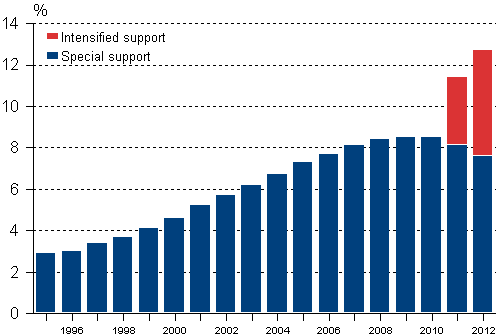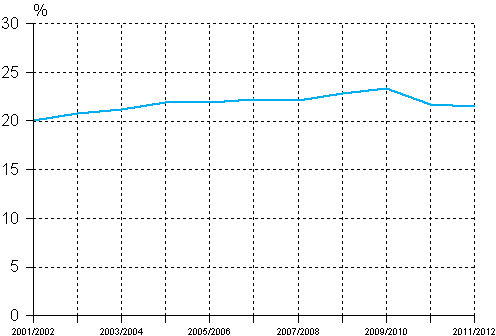Published: 12 June 2013
Intensified or special support was received by 13 per cent of comprehensive school pupils
Intensified or special support was received by 12.7 per cent of comprehensive school pupils in autumn 2012. Their share was good one percentage point higher than in 2011. The number of pupils receiving intensified support, which is not as extensive as special support, increased by 53 per cent from 2011 to 27,400 pupils, while the number of pupils receiving special support decreased by seven per cent to 41,000 pupils. Of the pupils receiving special support, 52 per cent received at least 80 per cent of their teaching in a special group. These data derive from Statistics Finland’s education statistics.
Share of comprehensive school pupils having received intensified or special support among all comprehensive school pupils 1995–2012, %

1) Pupils accepted or transferred to special education during 1995 to 2010 have been regarded as equal to pupils having received special support.
From 2011 onwards, the support received by comprehensive school pupils became tripartite. Support to learning and school attendance can be divided into general, intensified and special support, depending on the duration and extent of the support. If general support is not enough, intensified support is provided, and if intensified support is not sufficient, special support is given. The statistics on special education in comprehensive schools mainly contains data on intensified and special support.
More intensified support was arranged in all regions in 2012 than in 2011. The share of recipients of intensified support among all pupils was highest in Åland at 14 per cent, and lowest in Kainuu at 3 per cent. The share of recipients of special support was highest in the region of Päijät-Häme, where it was 10 per cent. On Mainland Finland, the ratio of recipients of special support to the total number of pupils was lowest in Central and North Ostrbothnia at good 5 per cent in both. In Åland, a little under 5 per cent of pupils received special support.
Seventy-four per cent of the pupils who received intensified support received part-time special education, 57 per cent received remedial teaching, and 45 per cent special needs assistance and/or interpretation services. Thirty-eight per cent of the pupils who received special support received part-time special education, 34 per cent received remedial teaching, and 55 per cent special needs assistance and/or interpretation services.
Among the recipients of intensified support, 66 per cent were boys and 34 per cent girls. Among the recipients of special support, 69 per cent were boys and 31 per cent girls. Twenty-seven per cent of the pupils receiving special support had extended duration of compulsory education.
Among the recipients of special support, 19 per cent received all education in a general education group and 41 per cent received all education in a special education group. Among the recipients of intensified support, 40 per cent received part of the education in a general education group and part in a special education group.
Good 44 per cent of the pupils having received special support in grades 1 to 9 and during additional education of the comprehensive school studied general education syllabuses in all subjects. Fourteen per cent of the pupils had individualised syllabuses for one subject, 12 per cent for two to three subjects, and 24 per cent for four or more subjects. Five per cent of the pupils receiving special support studied according to functional skill areas. The teaching can be arranged according to functional skill areas if it cannot be arranged by subject syllabuses due to the pupil's severe disability or illness.
Of comprehensive school students in autumn 2011, 21.5 per cent, or 116,300 students received part-time special education during the 2011-2012 academic year. The share decreased a bit from the previous academic year. In autumn 2011, part-time special education was included in intensified support for 13,900 pupils and in special support for 15,000 pupils. Some 87,400 pupils or 16 per cent of comprehensive school students received part-time special education as general support.
Overall, some 149,400 of the comprehensive school students in autumn 2011 received part-time special education arranged either as general, intensified or special support. This corresponds with 28 per cent of all students.
Share of comprehensive school pupils having received part-time special education among all comprehensive school pupils in academic years 2001/2002 to 2011/2012

During 2011, a total of 20,100 students in vocational education leading to a qualification received special education. The number was 750 higher than in the year before. The share of special education students was 7.2 per cent among all students and 14.3 per cent among students attending vocational education aimed at young persons (curriculum-based basic vocational education provided by educational institutions).
The share of men among the students of special vocational education was 59 per cent. Thirteen per cent of the special education students attended special vocational education institutions and 9 per cent studied in special groups of other institutions providing vocational education. The share of students who studied in same groups as other students (were integrated) was 78 per cent. Nearly one-half of the special vocational education students studied in the field of technology and transport.
Source: Education. Statistics Finland
Inquiries: Riikka Rautanen 09 1734 2375, koulutustilastot@stat.fi
Director in charge: Riitta Harala
Publication in pdf-format (269.6 kB)
- Tables
-
Tables in databases
Pick the data you need into tables, view the data as graphs, or download the data for your use.
Appendix tables
- Appendix table 1. Comprehensive school pupils having received intensified or special support, 2012 (12.6.2013)
- Appendix table 2. Part-time special education, remedial teaching, and special needs assistance and interpretation services received by comprehensive school pupils having received intensified or special support, 2012 1) (12.6.2013)
- Apprendix table 3. Comprehensive school puplis having received intensified support 2011 - 2012 (12.6.2013)
- Apprendix table 4. Comprehensive school puplis having received special support by duration of compulsory education, 2012 (12.6.2013)
- Appendix table 5. Comprehensive school pupils having received special support by place of provision of teaching, 2012 (12.6.2013)
- Appendix table 6. Pupils having received special support on grades 1-9 and during additional education of comprehensive school by subject syllabus, 2012 (12.6.2013)
- Appendix table 7. Comprehensive school pupils having received special support, 1995-2012 1) (12.6.2013)
- Appendix table 8. Comprehensive school pupils having received part-time special education from academic year 2001/2002 to academic year 2011/2012 1) (12.6.2013)
- Appendix table 9. Students of special vocational education by place of provision of teaching, 2004-2011 (12.6.2013)
Updated 12.6.2013
Official Statistics of Finland (OSF):
Support for learning [e-publication].
ISSN=1799-1617. 2012. Helsinki: Statistics Finland [referred: 26.12.2025].
Access method: http://stat.fi/til/erop/2012/erop_2012_2013-06-12_tie_001_en.html

